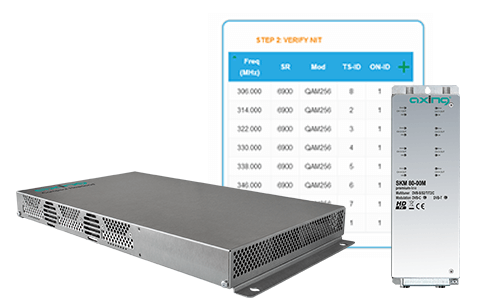SMARTPortal for headends
In addition to middleware servers, headends and IPTV streamers as well as encoders can be controlled. You can make all settings for the headend, e.g. configure and sort input and output channels. If a change is made on a satellite transponder, enter the updated parameters. Copy the settings of a headend and import them into another headend of the same type to keep them in sync. Perform software updates or upgrades. Save your settings for the headends using the SMARTPortal. You can grant an in-house technician on site access to the settings, but retain full control. Access to the portal and system events are stored in a log file. If critical events occur, the system sends an e-mail to the owner.
Prerequisites
All headends of the SKM, MK, HKM series can be integrated into the SMARPortal. The devices must be connected to the Internet for use. Their Ethernet connection is usually integrated into the local network. No special router configuration or additional software is required on site. The license to use the SMARTPortal is free of charge in the introductory phase.
Advantages:
- Remote service, configuration and software maintenance of all headends via a single access
- Administration of user authorizations and logging of accesses
- LAN integration without special router configuration and secure transmission
- Notification of important system events
- Optional support by the AXING service
Edit NIT and switch off individual PIDs of headends
We offer two extensions for individual adjustment of our new headend generation (series MK XX-0X and SKM XX-oX): The MKS 1-00 extension generates a NIT table, the MKS 1-01 enables PID filtering. The AXING Support will install both extensions on customer request. Both software functionalities are explained in detail below:
NIT – Network Information Table
With the software extension MKS 1-00, a NIT (Network Information Table) can be read out of the devices, edited and uploaded back into the devices. The NIT Network Information Table transmits a series of parameters in the digital data stream that are necessary for a scan of the receivers. The specific parameters within the NIT, such as ONID – Original Network ID and TS-ID – Transmitting Subscriber ID, can each be configured. In addition, transmission parameters can be added and changed manually from other AXING headends as well as from headends of other manufacturers. This makes it easy to manage the receivers’s channels at the headend. The channel searching procedure will be faster and more reliable.
NIT editing
The LCN (Logical channel numbering) is also located within the NIT, which enables virtual channel list assignment for TV/radio programmes. Receivers which support LCN sort the program automatically after running a search process. With the MKS 1-00, synchronization is also possible if several headends are used. Within the cable network, the user always finds a program on the same program position.
PID – Packet Identifier
Each digital data stream (transport stream) is composed of several elementary streams, each elementary stream having its own identifier, the so-called PID. An elementary stream can be a video, audio or data stream. Some transport streams contain several audio languages (audio PIDs), for example.
PID filtering
If not all channel data streams are required due to the application, PID filtering is possible with the software extension MKS 1-01. All existing PIDs of a transport stream are listed, which can then be selected individually. For example, you can suppress audio PIDs with foreign language sound channels or AC-3 surround sound. Teletext can be excluded for use in a correctional facility. If PIDs are deselected, the transport stream is marked as modified and this particular stream element is no longer transmitted. This reduces the overall data rate of a transport stream, resulting in a lower bandwidth. This can become important for conversion from DVB-S to DVB-T, since a DVB-T channel has a lower data capacity. Data rate can be “saved” by filtering. Furthermore, the SIDs (Service ID) can be reassigned via this function with the software extension MKS 1-01.
Advantages:
- Generate a common NIT, speed up and simplify the program search of the receivers
- Allows a channel list assignment via LCN for all receivers using multiple headends
- PID filtering meets operator requirements (e.g. exclusion of teletext)
- Offers full control over the services in the cable network
Hybrid IPTVSolution
A lot of buildings have existing coaxial cable network infrastructures. If a building should be modernized to bidirectional interactive TV, the TV signals and interactive functions are normally distributed through an Ethernet structure. With AXING’s so called hybrid IPTVSolution, Live TV is supplied the traditional way (via coaxial cable) and all interactive functions are distributed via the existing (hotel) internet system. The IP network can be an Ethernet or WiFi network.
The hybrid solution is mainly suited for upgrading existing coaxial TV networks to an interactive TV system (e.g. in hotels). The big advantage of this solution is that no Ethernet infrastructure with high bandwidth is required and that the existing WIFI suffices to distribute the interactive services. The only requirement is to use AXING approved hospitality TVs with its own WIFI. Of course the hybrid solution can be expanded to a Full IPTV solution at any time.








